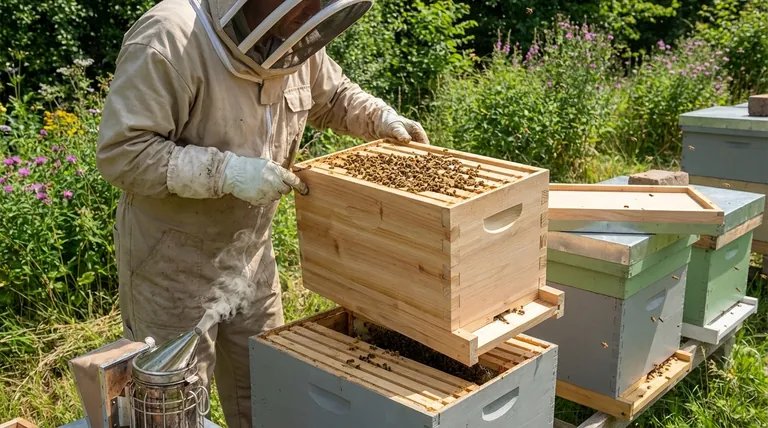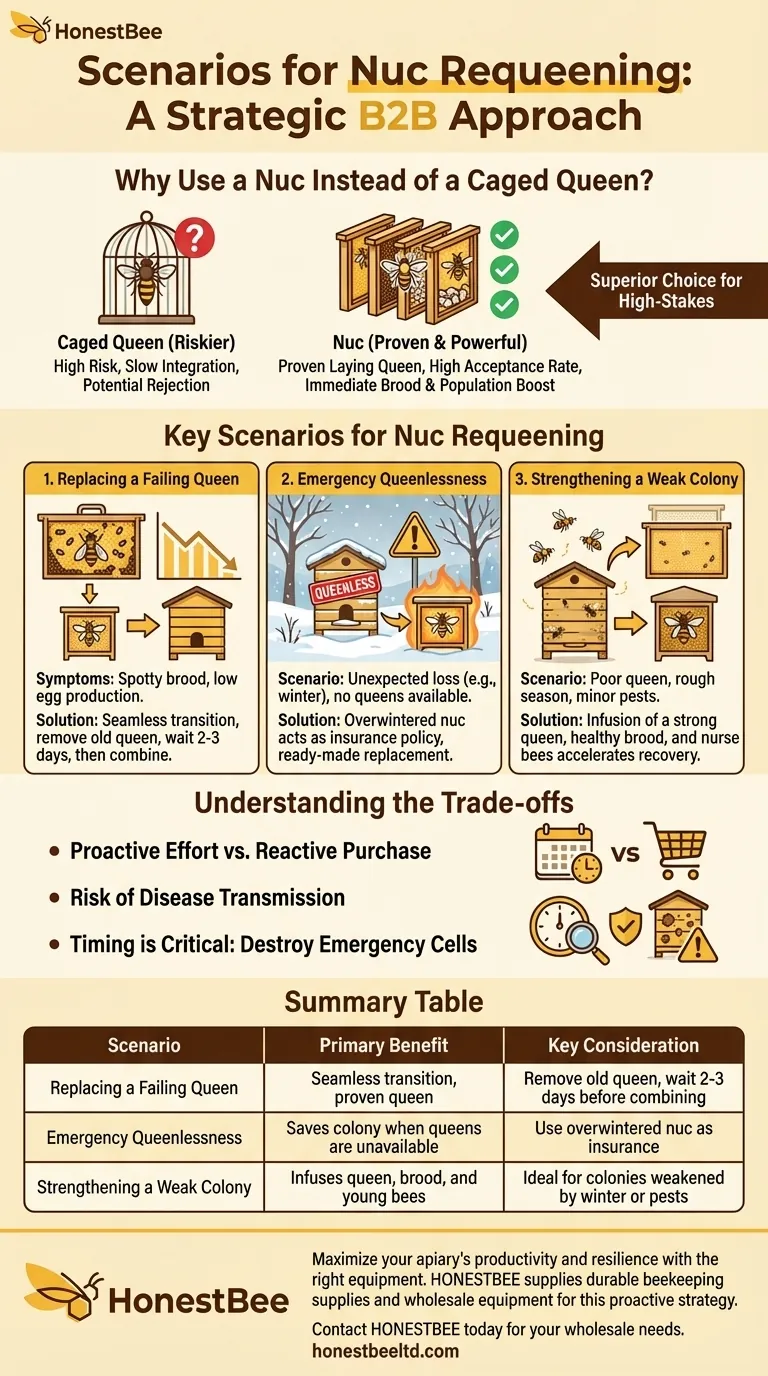Using a nucleus colony, or "nuc," for requeening is a powerful technique for specific, high-stakes situations. It is most valuable when you need to replace a failing queen in a production hive, when a colony becomes unexpectedly queenless outside of the normal season for buying queens (like in winter), or when you want to ensure the highest possible chance of acceptance with minimal disruption to the hive's brood cycle.
Requeening a hive is a critical but often risky procedure. The core value of using a nuc is that you aren't just introducing a queen; you are transplanting an entire, established mini-colony with a proven, laying queen, which dramatically increases the probability of success and reduces hive downtime.

Why Use a Nuc Instead of a Caged Queen?
While buying a single caged queen is common, using a full nuc is a fundamentally different approach. It solves many of the problems that can lead to a failed requeening.
A Proven, Laying Queen
When you use a nuc, you are introducing a queen who is already accepted by her own bees and is actively laying. You can inspect the nuc's frames to verify she has a solid, healthy brood pattern before you ever introduce her to the larger colony. This eliminates the risk of introducing a poorly mated or otherwise faulty queen.
Dramatically Higher Acceptance Rates
A full-strength colony can be hostile to a foreign queen in a small cage. By introducing the queen with several frames of her own bees, brood, and resources, you are introducing her entire "court." The familiar scent of her and her brood makes acceptance by the host colony much more likely.
A Boost of Population and Brood
Introducing a nuc doesn't just replace the queen; it also adds thousands of young bees and frames of eggs, larvae, and pupae. This infusion of new life gives the colony an immediate boost, helping it build strength faster than it would waiting for a new queen to start laying from scratch.
Key Scenarios for Nuc Requeening
Certain situations make using a nuc the clearly superior strategic choice for maintaining hive health and productivity.
Replacing a Failing Queen
The most common sign of a failing queen is a spotty brood pattern or a noticeable decline in egg production. Instead of a solid carpet of brood, you will see scattered cells and an inconsistent laying pattern. Using a nuc provides a seamless transition.
The process involves removing the failing queen, waiting two to three days for the colony to recognize its queenlessness, and then combining the hive with the nuc, typically by placing the nuc frames together in the center of the brood box.
Emergency Queenlessness
A colony can lose its queen unexpectedly from a swarm, an inspection accident, or old age. This is especially dangerous during late fall or winter when purchasing a new mated queen is impossible.
An overwintered nuc is your insurance policy. It provides a ready-made replacement that can save a colony that would otherwise be doomed.
Strengthening a Weak Colony
A colony may become weak due to a poor queen, a rough winter, or minor pest pressure. A nuc provides a powerful remedy. The combination infuses the weak hive with a strong queen, healthy brood, and a fresh population of nurse bees to turn its fortunes around.
In extreme cases, a very small cluster of bees can be moved into the smaller nuc hive body. The confined space is easier for the small population to defend against pests like wax moths and small hive beetles while they rebuild.
Understanding the Trade-offs
While powerful, using nucs for requeening is not without its own considerations. It requires more planning and resources than simply buying a single queen.
Proactive Effort vs. Reactive Purchase
Maintaining nucs requires extra equipment, time, and management. You must raise or purchase them in advance. This is a proactive strategy that requires planning, whereas buying a caged queen is a simple, reactive purchase.
Risk of Disease Transmission
Never use a nuc to "save" a colony suffering from a serious disease like American Foulbrood (AFB). Doing so will only infect your healthy nuc. Always diagnose the underlying cause of a colony's weakness before attempting to combine it with another.
Timing is Critical
When you combine the nuc with the queenless hive, you must be certain the host colony has no existing queen cells. If the bees have already started raising their own emergency queen, they will almost certainly kill the new queen from your nuc. All emergency cells must be destroyed before combining.
Making the Right Choice for Your Apiary
Deciding whether to use a nuc depends on your specific goals and management style.
- If your primary focus is maximum productivity and low risk: Proactively raise nucs alongside your production hives so you always have a vetted, laying queen ready for a seamless replacement.
- If your primary focus is self-sufficiency and winter survival: Use overwintered nucs as your "backup queens" to save colonies that become queenless when commercial queens are unavailable.
- If your primary focus is saving a weak but otherwise healthy colony: Use a nuc to provide a critical infusion of a laying queen, nurse bees, and sealed brood to accelerate its recovery.
Ultimately, integrating nucs into your beekeeping practice transforms requeening from a risky necessity into a predictable and powerful management tool.
Summary Table:
| Scenario | Primary Benefit | Key Consideration |
|---|---|---|
| Replacing a Failing Queen | Seamless transition with a proven, laying queen | Remove old queen and wait 2-3 days before combining |
| Emergency Queenlessness | Saves colony when queens are unavailable (e.g., winter) | Use an overwintered nuc as an insurance policy |
| Strengthening a Weak Colony | Infuses hive with a queen, brood, and young bees | Ideal for colonies weakened by winter or pests |
Maximize your apiary's productivity and resilience with the right equipment.
For commercial apiaries and beekeeping equipment distributors, using nucs for requeening is a powerful strategy to minimize hive downtime and ensure successful queen acceptance. HONESTBEE supplies the durable beekeeping supplies and wholesale equipment you need to implement this proactive approach effectively.
Contact HONESTBEE today to discuss your wholesale needs and learn how our solutions can support your requeening strategy and overall hive management success.
Visual Guide

Related Products
- 5 Frame Wooden Nuc Box for Beekeeping
- HONESTBEE Advanced Ergonomic Stainless Steel Hive Tool for Beekeeping
- HONESTBEE Professional Long Handled Hive Tool with Precision Cutting Blade
- Professional Dual-End Stainless Steel Hive Tool for Beekeeping
- HONESTBEE Professional Multi-Functional Hive Tool with Ergonomic Wood Handle
People Also Ask
- What is the advantage of overwintering a nucleus? A Strategic Asset for Beekeeping Success
- What is the purpose of having a nuc in beekeeping? Build a Resilient & Productive Apiary
- What is a common feature of many 5-frame nuc boxes? The Integrated Feeder for Efficient Colony Growth
- What frames should be moved into the queenless hive when requeening with a nuc? Ensure a Successful Queen Introduction
- How should the nuc be installed in the apiary? Ensure Colony Success from Day One



















